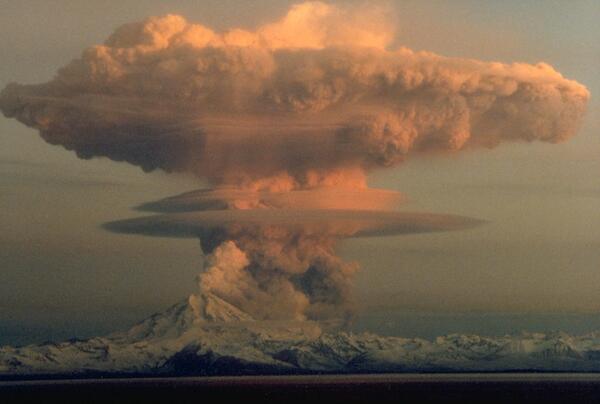Sinabung volcano in Indonesia on August 14, 2016. Photograph credit: Christoph Kern, USGS
How dangerous are pyroclastic flows?
A pyroclastic flow is a hot (typically >800 °C, or >1,500 °F ), chaotic mixture of rock fragments, gas, and ash that travels rapidly (tens of meters per second) away from a volcanic vent or collapsing flow front.
Pyroclastic flows can be extremely destructive and deadly because of their high temperature and mobility. For example, during the 1902 eruption of Mont Pelee in Martinique (West Indies), a pyroclastic flow (also known as a “nuee ardente”) demolished the coastal city of St. Pierre, killing nearly 30,000 inhabitants.
Learn More: Pyroclastic flows move fast and destroy everything in their path
Related
Can an eruption at one volcano trigger an eruption at another volcano?
Do earthquakes large enough to collapse buildings and roads accompany volcanic eruptions?
Can volcanic eruptions endanger helicopters and other aircraft?
Can lakes near volcanoes become acidic enough to be dangerous to people and animals?
How many active volcanoes are there on Earth?
How Do Volcanoes Erupt?
Which volcanic eruptions were the deadliest?
What are some benefits of volcanic eruptions?
What was the largest volcanic eruption in the 20th century?
Which volcanoes in the contiguous United States have erupted since the Nation was founded?
Sinabung volcano in Indonesia on August 14, 2016. Photograph credit: Christoph Kern, USGS
The United States has 169 active volcanoes. More than half of them could erupt explosively, sending ash up to 20,000 or 30,000 feet where commercial air traffic flies. USGS scientists are working to improve our understanding of volcano hazards to help protect communities and reduce the risks.
Video Sections:
The United States has 169 active volcanoes. More than half of them could erupt explosively, sending ash up to 20,000 or 30,000 feet where commercial air traffic flies. USGS scientists are working to improve our understanding of volcano hazards to help protect communities and reduce the risks.
Video Sections:
Ascending eruption cloud from Redoubt Volcano as viewed to the west from the Kenai Peninsula. The mushroom-shaped plume rose from avalanches of hot debris (pyroclastic flows) that cascaded down the north flank of the volcano. A smaller, white steam plume rises from the summit crater.
Ascending eruption cloud from Redoubt Volcano as viewed to the west from the Kenai Peninsula. The mushroom-shaped plume rose from avalanches of hot debris (pyroclastic flows) that cascaded down the north flank of the volcano. A smaller, white steam plume rises from the summit crater.
It begins with curiosity—How do scientists learn from volcanoes?
Field-trip guide for exploring pyroclastic density current deposits from the May 18, 1980, eruption of Mount St. Helens, Washington
The Novarupta-Katmai eruption of 1912 - largest eruption of the twentieth century; centennial perspectives
U.S. Geological Survey (USGS) Western Region Kasatochi Volcano Coastal and Ocean Science
Related
Can an eruption at one volcano trigger an eruption at another volcano?
Do earthquakes large enough to collapse buildings and roads accompany volcanic eruptions?
Can volcanic eruptions endanger helicopters and other aircraft?
Can lakes near volcanoes become acidic enough to be dangerous to people and animals?
How many active volcanoes are there on Earth?
How Do Volcanoes Erupt?
Which volcanic eruptions were the deadliest?
What are some benefits of volcanic eruptions?
What was the largest volcanic eruption in the 20th century?
Which volcanoes in the contiguous United States have erupted since the Nation was founded?
Sinabung volcano in Indonesia on August 14, 2016. Photograph credit: Christoph Kern, USGS
Sinabung volcano in Indonesia on August 14, 2016. Photograph credit: Christoph Kern, USGS
The United States has 169 active volcanoes. More than half of them could erupt explosively, sending ash up to 20,000 or 30,000 feet where commercial air traffic flies. USGS scientists are working to improve our understanding of volcano hazards to help protect communities and reduce the risks.
Video Sections:
The United States has 169 active volcanoes. More than half of them could erupt explosively, sending ash up to 20,000 or 30,000 feet where commercial air traffic flies. USGS scientists are working to improve our understanding of volcano hazards to help protect communities and reduce the risks.
Video Sections:
Ascending eruption cloud from Redoubt Volcano as viewed to the west from the Kenai Peninsula. The mushroom-shaped plume rose from avalanches of hot debris (pyroclastic flows) that cascaded down the north flank of the volcano. A smaller, white steam plume rises from the summit crater.
Ascending eruption cloud from Redoubt Volcano as viewed to the west from the Kenai Peninsula. The mushroom-shaped plume rose from avalanches of hot debris (pyroclastic flows) that cascaded down the north flank of the volcano. A smaller, white steam plume rises from the summit crater.















